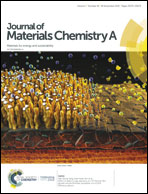Highly flexible and sensitive temperature sensors based on Ti3C2Tx (MXene) for electronic skin†
Abstract
Electronic skin (e-skin) has been attracting great research interest and effort due to its potential applications in wearable health monitoring devices, smart prosthetics, humanoid robots and so on. Temperature is an important parameter for e-skin to perceive surroundings and people. However, little research has been carried out in the field of flexible temperature sensing and current temperature sensors still face many challenges in practical applications, such as high sensing performance, facile preparation, and differentiating from other stimuli. Herein, we develop a facile fabrication strategy for Ti3C2Tx based temperature sensors. As the sensing units, Ti3C2Tx nanoparticles and lamellae can be obtained simultaneously through controlling the fabrication conditions. These temperature sensors exhibit tunable sensing performances and a desirable combination of a high sensitivity (up to 986 °C−1) and a wide working range (140 °C). Due to their high sensitivity, these sensors can also be used as e-skin for proximity detection and illumination detection from ultraviolet to infrared light. For application demonstration, a 4 × 4 array of the sensors was fabricated for temperature mapping, indicating their great potential for monitoring approaching objects and temperature variations.



 Please wait while we load your content...
Please wait while we load your content...